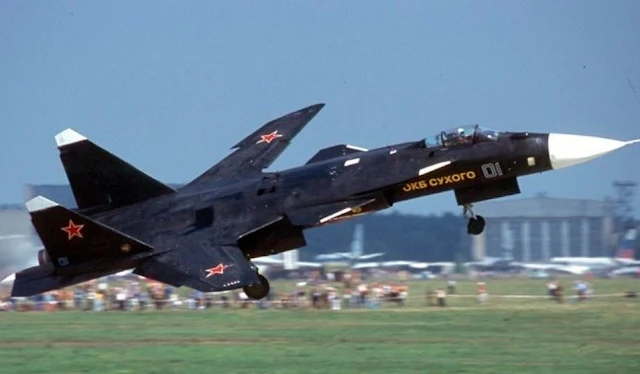 |
| The Sukhoi Su-47 Berkut Fighter That Became Bridge Russia's Modern Drone |
International Military - The Su-47 Berkut can reportedly assist Russia in building an Unmanned Aerial Vehicle (UAV). However, Rostec, the state-owned defense conglomerate, did not provide specific details.
Please note, the Su-47 Berkut is an ancient aircraft. This plane flew for the first time in 25 years. More precisely, he flew in September 1997, when Sukhoi Design Bureau test pilot Igor Votintsev took to the air with this aircraft. The Sukhoi Su-47 Berkut was first introduced to the general public during the MAKS-1999 air show, where it conducted a test flight.
Quoted from the Eurasian Times, this experimental fighter exemplifies how things that seemed strange in the past are possible with modern materials. Only one aircraft was built and it never made it to the assembly line. However, it provides a lot of important data for Russian aviation engineers.
The colossal knowledge of an inverted sweep wing constructed from composite materials obtained during the Berkut tests was used in developing an unmanned aerial vehicle. The wing swept back reduces inductive drag. This improves takeoff and landing characteristics, maneuverability, and subsonic flight range.
However, the report did not say how much expertise was used in the Russian drone development process. The process of building the Su-47 is believed to have produced a wealth of knowledge that greatly helped the Russian aviation industry in creating a modern aircraft.
 |
| The Russian Sukhoi Su-47 Berkut Fighter |
The Sukhoi Su-47 Berkut fighter jet received a lot of attention from the media and western defense experts during its development. It was instantly dubbed the fighter of the 21st century, and reports of its planned mass production were widely published.
Quoted from Airforce Technology, the Su-47 was introduced in January 2000 and completed the first flight test phase in December 2001. In this case, maneuverability is the most important thing for the Su-47.
The Sukhoi Su-47 is known to have very high agility at subsonic speeds. This then allows the aircraft to change its angle of attack and flight path very quickly. It also maintains maneuverability in supersonic flight. The high turn rate of the Su-47 also allows the pilot to quickly turn the fighter towards the next target to initiate a weapons launch.
Compared to a wing sweeping back over the same area, a wing sweeping forward provides a number of advantages. First, a higher lift-to-drag ratio; higher capacity in aerial combat maneuvers, and higher range at subsonic speeds. Then, there is also an increase in stall resistance and anti-turn characteristics; increased stability at high angles of attack; lower minimum flight speed; and shorter takeoff and landing distances.
